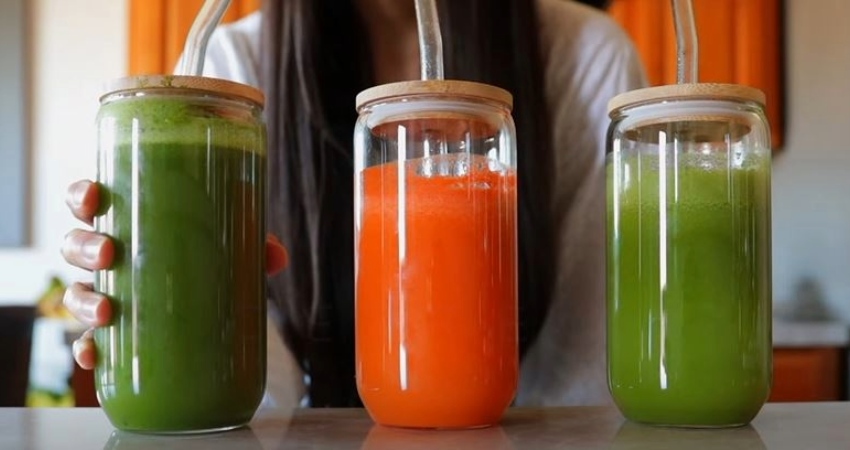How does it sound starting your morning with a nutrient-rich juice? Yes it is one of the simplest ways to improve energy levels and maintain overall health? In my personal wellness journey, juicing has become a small daily ritual that makes a big impact. I know like everyone else you too want to support your immune system, make digestion better, and energize your body with natural energy from home prepared juices. Today I am here to fulfil all your body needs with three most carefully selected morning juice recipes that will prove a game-changer for you.
Each recipe below is beginner-friendly, uses accessible ingredients, and delivers maximum vitamins, minerals, and hydration. I’ll also share practical juicing tips, equipment suggestions, and storage guidance to help you get the most out of your morning juice habit.
🥬 1. Detoxifying Green Juice (Energizing Morning Booster)
This vibrant green juice is one I reach for every morning after a workout or paired with a light breakfast. It’s loaded with chlorophyll-rich greens, vitamin C, and anti-inflammatory compounds that leave you feeling cleansed and ready for the day.
Ingredients:
- 1 apple (for natural sweetness and fiber)
- 2 cups kale (packed with vitamins A, C, and K)
- 2 cups spinach (a great source of iron and magnesium)
- 1 lemon (boosts detox and alkalizes the body)
- 1 small piece of ginger (for digestion and immunity)
- Optional: 1 scoop greens powder (if fresh greens aren’t available)
Instructions:
- Wash all ingredients thoroughly.
- Depending on your juicer (especially if it’s a centrifugal model), chop the ingredients to fit into the chute.
- Juice all ingredients, starting with the leafy greens.
- If using greens powder, stir it in after juicing.
- Serve immediately or store in an airtight glass bottle for up to 24 hours in the fridge.
Why It Works:
This juice supports liver detox, balances pH levels, and supplies your body with plant-based antioxidants. It’s a great entry point if you’re new to juicing and want something both nutritious and palatable.
🍊 2. Immune-Boosting Orange Carrot Elixir
This juice is my go-to during cold and flu season. It’s bright, tangy, and filled with immune-enhancing nutrients that help protect your body and speed up recovery.
Ingredients:
- 1 large orange or 2 small ones (rich in vitamin C)
- 4 carrots (loaded with beta-carotene and vitamin A)
- 1 lemon (natural antioxidant)
- 1 small piece of ginger (anti-inflammatory and supports circulation)
- 1 small piece of turmeric (fights oxidative stress)
- Optional: Pinch of turmeric powder and/or ginger powder if fresh isn’t available
Instructions:
- Peel the orange and lemon if preferred (to reduce bitterness).
- Chop all ingredients into smaller pieces.
- Add to your juicer and extract the juice.
- Stir and taste. Add a small pinch of black pepper if using turmeric to aid absorption.
Why It Works:
The powerful combo of citrus, root vegetables, and spices delivers a punch of antioxidants, supports inflammation reduction, and helps ward off illness. The bright flavor makes it a favorite among both adults and kids.
🍍 3. Hydrating Pineapple-Celery Cooler
When I need something refreshing and light—especially in the summer—this hydrating juice is perfect. It quenches thirst and replenishes electrolytes naturally.
Ingredients:
- 1 cup fresh pineapple (rich in bromelain and digestive enzymes)
- 1 medium cucumber (hydrating and cooling)
- 2–3 stalks of celery (supports alkalinity and fluid balance)
- 1 lime (boosts flavor and adds vitamin C)
Instructions:
- Wash all produce thoroughly—especially celery and cucumbers.
- Peel the lime (optional).
- Cut all produce into manageable sizes.
- Juice and stir well before serving.
Why It Works:
Every ingredient in this blend has a high water content, which makes it ideal for hot days or after a sweaty workout. It supports hydration, digestion, and keeps you feeling light and energized.
📊 Nutritional Summary (Per Juice)
Adding a basic nutrient breakdown per juice increases transparency and helps readers track intake.
| Juice Type | Calories | Vitamin C | Fiber | Sugar | Key Benefits |
| Green Detox | ~100 | High | Low | Low | Anti-inflammatory, cleansing |
| Carrot Citrus | ~120 | Very High | Low | Moderate | Immune boosting |
| Pineapple Hydration | ~130 | High | Low | Moderate | Hydrating, digestion support |
🥤 Best Juicer for Beginners
If you’re just starting out, I recommend a budget-friendly centrifugal juicer. Also they’re fast and easy to clean. While they may not preserve nutrients as well as masticating juicers, they’re a great first step. Make sure to chop produce appropriately based on your model, and clean your juicer right after use to prevent staining or buildup.
For more efficient nutrient extraction and less oxidation, you may want to upgrade to a cold press juicer later on.
Also, I’ve been using a set of glass cups with lids and straws that I bought on Amazon, and they’ve been a game-changer. Perfect for prepping ahead and taking juice on the go. I highly recommend them if you want to make juicing a more consistent habit.
🧼 Tips for Clean, Safe Juicing
- Buy organic produce when possible, especially for high-water-content items like cucumbers and celery.
- If organic isn’t an option, scrub and peel fruits and vegetables thoroughly.
- Always consume juices fresh or store in a glass bottle with lid for no more than 24–48 hours.
- Rinse your juicer immediately after use for easy cleaning and longevity.
More Related Recipes:
- Carrot Juice
- Juice recipes for beginners
- Juice for gut health
- Detox Juice Recipes
- Summer Juice Recipes
💡 Key Takeaways!
Juicing doesn’t have to be complicated. The key is consistency, using whole, clean ingredients, and choosing recipes that work for your schedule and taste preferences. These morning juice recipes are not only easy but they’re rich in ingredients that support overall health, hydration, and natural energy without added sugar or synthetic ingredients.
From someone who has made juicing a daily habit, I can tell you: the benefits show up quickly in your skin, digestion, and energy levels. Try these recipes and see how your mornings transform.
If you try one of these, let me know how it goes — I’d love to hear your favorites or what ingredients you tweak to make it your own. And don’t forget: the best juicing habits are the ones you can stick with, so keep it simple and enjoy the process.
Frequently Asked Questions About Morning Juice Recipes
Q: What Juicer Should You Use? (Beginner vs. Advanced Juicers)
Ans: There are two main types of juicers: centrifugal and slow (masticating) juicers.
Why: The type of juicer you use affects juice yield, nutrient retention, and ease of use.
Who:
- Beginners may prefer centrifugal juicers for speed and affordability.
- Health-conscious users might choose slow juicers for higher nutrient quality.
When: If you’re just starting out or juicing occasionally, a budget-friendly centrifugal model works. For daily juicing or detox plans, a slow juicer is worth investing in.
How:
- Choose based on your time, budget, and nutritional goals.
- Look for models with easy cleanup and wide feeding chutes.
Q: When to Drink These Juices for Best Results?
Ans: Morning is ideal, but not the only time.
Why: Drinking juice on an empty stomach allows your body to absorb nutrients quickly and boosts energy levels without bloating.
Who:
- Anyone with digestion issues or sluggish mornings can benefit most from AM juicing.
- Athletes or active individuals might use juices pre- or post-workout.
When:
- Morning (6 AM – 10 AM) for digestion and energy.
- Post-exercise for hydration and recovery.
- Mid-afternoon for a clean energy pick-me-up (instead of coffee or snacks).
Q: 💰 How Much Do These Juices Cost to Make?
Ans: Home juicing can be affordable and will cost you around $1.50–$3 per serving.
Why: Making your own juice is cheaper, healthier, and more customizable than store-bought options, which often contain added sugar or preservatives.
Who:
- Budget-conscious families
- Individuals avoiding processed sugar
- Health enthusiasts tracking macros or calories
When: Shop for seasonal produce to cut costs and increase freshness.
Q: Who Should Be Cautious with Juicing?
Ans: While juicing has many benefits, it’s not for everyone in every situation.
Why: Some juices (especially fruit-based) are high in natural sugars and may affect blood sugar levels.
Who:
- Diabetics or people with insulin resistance should use more low-sugar vegetables.
- People with kidney conditions should limit high-oxalate greens like spinach.
- Pregnant women should consult a doctor before detox juicing.
Q: 🧼 How to Store Fresh Juice Safely?
Ans: Fresh juice has no preservatives and spoils quickly.
Why: Nutrients degrade over time, and unsafe storage can lead to bacterial growth.
Who:
- People doing juice cleanses or batch prepping need proper storage info.
When: Drink within 24–72 hours max.
Method to store:
- Use airtight glass jars.
- Store immediately in the fridge.
- Add lemon or lime juice to extend shelf life naturally (due to vitamin C’s antioxidant properties).
Q: 🤔 What if You Don’t Have a Juicer?
Ans: There is nothing to worry if you don’t have a juicer as you can still make juices using a blender and strainer.
Why: This method works if you’re just starting out and not ready to buy a juicer.
Who:
- Beginners
- Students or travelers
- Anyone on a tight budget
How:
- Blend ingredients with a small amount of water.
- Pour the mix into a nut milk bag, cheesecloth, or fine mesh strainer.
- Squeeze out the juice.
This method may take more time, but it still gives you most of the flavor and nutritional benefits.
Q: I have diabetes. Can I drink these juices?
Ans: If you’re diabetic, choose low-sugar vegetables (like spinach, cucumber, celery) and avoid high-glycemic fruits (like bananas or pineapples). Always consult your doctor before making juice a daily habit.

